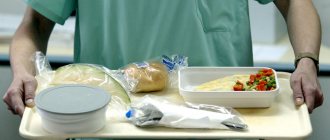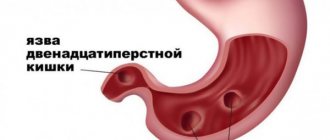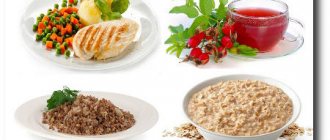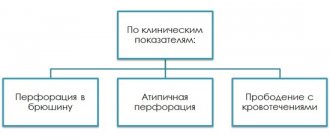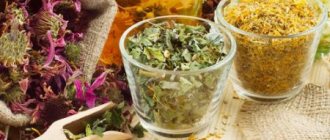Main principles
The causative agent of gastrointestinal ulcers and perforation of ulcers is a spiral-shaped bacterium called Helicobacter pylori. It affects the mucous membranes of the stomach. The pathological process is accompanied by:
- pain in the lower abdomen;
- frequent belching;
- nausea;
- heartburn.
Lack of or delayed treatment will lead to complications that are dangerous to humans. During therapy, it is recommended to adhere to a special diet. The patient's diet should contain only those foods that stimulate the secretion of juice in the stomach. Dishes from the menu help protect the mucous membranes of the gastrointestinal tract from mechanical or thermal damage. Patients are advised to eat food at room temperature, always in processed form.
The diets used for exacerbations of gastric and duodenal ulcers are dominated by:
- milk products;
- porridge;
- vegetable soups;
- chicken or turkey that has undergone culinary processing - boiled or steamed.
It will take at least 10-12 days to stick to this diet. The menu is based on the following principles:
- Nutrition for ulcerative pathologies is fractional, in small portions. A day from 4 to 5 times.
- When preparing a diet, preference is given to low-calorie dishes.
- Products are boiled or steamed. Afterwards, the food is crushed or passed through a blender or meat grinder.
- The consistency of the dishes should resemble liquid porridge or soup.
- Preference is given to food at room temperature.
- Consumption of salt and spices is limited as much as possible.
Dietary table No. 1
At this stage of the patient’s recovery after surgery, the diet is expanded, fruits, vegetables, and cheeses are added.
The forbidden menu remains:
- seasonings;
- spicy;
- fried or baked until crusty;
- any alcoholic drinks;
- sour fruits;
- marinades;
- baked goods;
- carbonated drinks;
- coarse vegetables (white cabbage, radish, onion, sorrel);
- smoked and canned;
- fat;
- coarse cereals (barley, corn);
- rough meat with fibers;
- ice cream;
- chocolate products;
- fried or hard-boiled eggs.
List of dishes on the first day of the diet
For breakfast they make cottage cheese casserole with pears, sweet tea, and a piece of mild cheese.
For a snack, fruit jelly is made from apples.
For lunch, chicken breast soup with potatoes and carrots, rosehip infusion and white crackers are allowed.
For an afternoon snack, prepare a steam omelette with milk.
For dinner, steamed pollock cutlet and stewed zucchini.
Diet for the second day
Milk soup with noodles, dried fruit compote.
For second breakfast, boil a soft-boiled egg and yogurt.
For lunch, buckwheat porridge, steamed turkey cutlet, tea.
For an afternoon snack, a glass of kefir with one cracker is suitable.
What products can
Nutrition for duodenal ulcers should be given special attention. A list of products that can be included in the diet is provided by a gastroenterologist. The doctor takes into account the degree of development of the pathology, the presence of concomitant diseases, the age category and gender of the patient.
The patient's menu includes:
- lean meats - chicken, veal, beef, turkey;
- crackers, yesterday's or dried wheat bread;
- cracker;
- puree soups - milk, cereal, chicken and vegetable;
- dairy products - cream, natural yogurt without additives, milk;
- low-fat river fish - pike perch, perch, pike;
- vegetables - zucchini, carrots, pumpkin, potatoes, beets;
- cereals – pearl barley, rice, semolina, buckwheat, oatmeal;
- pasta;
- berries – strawberries, wild strawberries, raspberries;
- oils – vegetable and butter;
- fruit jelly, jelly, compote.
In case of pathology, it is allowed to drink non-carbonated mineral water, berry decoctions, juices from fruits and vegetables, but non-acidic ones. It is better to ask your doctor what kind of fruits, cereals and vegetables you can eat for ulcer patients. It is advisable to prepare a diet together with a specialist so as not to harm the body.
Diet from 8 to 30 days
Improvement in the patient's condition after surgery and the absence of complications make it possible to expand the boundaries of the diet. Meals should be fractional and include multi-component dishes. Puree soups with diluted broths, vegetable purees, baked meat and fish dishes in the oven, and cottage cheese in small quantities should be gradually used as food.
Bakery products and easily digestible carbohydrates (sweets, chocolate, cakes, pastries) should also be excluded during this period. You can eat rye bread crackers prepared in the oven yourself.
After 2 weeks, you can eat soft-boiled eggs, dishes cooked in a small amount of butter and vegetable oil. You can drink tea with milk, eat pumpkin and carrot casseroles. As an afternoon snack, you can eat fruits such as bananas or pears. Soups may include potatoes, beets, and carrots. Sour fruits and vegetables can be eaten with caution only 2-3 months after surgical treatment.
For desserts, it is best to use soufflés, jelly, and mousse desserts made from permitted fruits. After 2 months you can eat dark chocolate, low-fat yoghurts, and butter cookies.
Products prohibited or partially restricted
With the development of peptic ulcer of the gastrointestinal tract, it is recommended to exclude from the menu:
- fatty fish – mainly sea fish;
- mushrooms;
- fatty meats - lamb, pork;
- excessively salted, pickled, fatty and fried foods;
- rye bread and pastries;
- canned food;
- sausages;
- ice cream;
- animal fats and lard;
- carbonated and alcohol-containing drinks.
A diet for duodenal ulcer, especially in the acute stage, involves avoiding:
- strong teas and coffee;
- fatty, rich broths;
- mushroom, meat and fish soups;
- fried vegetable dishes;
- spices and seasonings - horseradish, cloves, pepper, mustard are strictly prohibited.
List of products that irritate the mucous membranes of the gastrointestinal tract:
- turnip;
- peas;
- radish;
- beans;
- asparagus;
- stringy meat;
- berries and fruits with hard skin;
- radish;
- bakery products made from wholemeal flour.
Drinking diet
After surgery for duodenal ulcers, you cannot eat anything, even the amount of water is limited. On the second day, the patient can drink water, a little, but every 20 minutes. The drinking diet lasts from 2 to 4 days; your doctor will give you more accurate numbers.
If the patient feels well, later he is allowed to drink jelly or juices made from sweet fruits or berries. You can also make a decoction of rose hips. To do this in the evening, before going to bed, you need to pour 1 tbsp. fresh berries with clean cold water (2 cups), the next day bring the infusion to a boil.
Then patients can drink a more satisfying drink. What kind of drink is this? A weak fresh broth made from chicken, beef or turkey, or cereal infusions. Patients are also allowed to eat some fruit jelly. A person can drink up to 2.5 liters of various liquids per day, but without salt.
What to consider when creating a menu
Following a diet for erosion of the stomach and duodenum involves following certain rules. Violating them will have unpleasant consequences.
- The menu should be varied and contain microelements and vitamins necessary for the normal functioning of the body.
- You need to consume at least 3000 calories per day. Preference is given to food that is easily digestible, but at the same time satisfying and nutritious.
- The list of permitted products includes cereals. A gastroenterologist will advise you on what cereals you can eat. Usually this is rice, oatmeal and semolina.
- Fruits are not recommended to be consumed fresh; it is better to bake or boil them. Before eating, the product is peeled and grated.
- Patients with peptic ulcer disease can include canned food for children in their diet.
- Dairy products include cottage cheese, fresh milk, and a small amount of cream.
- Soups for ulcers should have the consistency of puree.
- Chicken eggs are allowed and served in a semi-liquid state - soft-boiled.
- When choosing between sugar and honey, it is better to give preference to the latter option. The bee product heals ulcers.
- Those with a sweet tooth are allowed to include healthy desserts with pectin in their diet - marmalade, marshmallows and marshmallows.
- The juice can be natural, unpackaged. It is better to dilute it with water.
- The rapid healing of ulcers or erosion is facilitated by the use of a decoction of wheat bran or rose hips.
Therapeutic nutrition for ulcer without perforation.
If you follow the correct therapeutic diet, then the ulcer will not perforate, and the ulcer itself may heal.
The nutritional features are:
- Products should reduce the production of gastric juice;
- Food should be gentle on the mucous membrane lining the stomach and intestines, without irritating it;
- Fairly quickly digested;
- Food should not be rough;
- You need to cook by steaming or in the oven, excluding fried and fatty foods;
- Eliminate all spices. There are no approved species for this disease.
All these rules are the basis of many weight loss diets. But diet and diet are different. In this case, you should adhere not only to the rules, but also to your feelings after eating.
Allowed products (sample menu):
- Protein – lean meat, seafood.
- Dairy products.
- Exclude fast food and flour products from the menu, as well as carbonated and sweet drinks, alcohol and nicotine!
- Cellulose. You can’t live without it, just like you can’t do without protein.
- Teas of different varieties. Coffee is not advisable.
- Food should be taken at a certain temperature, and not hot or cold - warm, so as not to cause discomfort.
- Mashed porridge is very useful.
- Various soups, but not with rich broth.
- Stewed vegetables, baked and vegetable broths and much more.
Table No. 1: weekly menu
If a diet is recommended for duodenal ulcers and chronic gastritis, it is better to prepare the menu for the week in advance. This way you can track its balance and correctness. Dietary dishes, when prepared correctly, have an extraordinary taste. We present an approximate diet for 7 days for patients with ulcers:
| Day/Meal | Breakfast | Lunch | Dinner | Afternoon snack | Dinner |
| first | Vermicelli with milk with the addition of natural honey, weak tea | Rosehip decoction, marshmallows | Boiled turkey, mashed potatoes, diluted peach juice | Low-fat kefir with crackers | Rice milk porridge, butter, a piece of dried bread, marmalade and rose hip decoction |
| second | Oatmeal porridge, steamed meatballs, tea | Natural yogurt | Vegetable cream soup, steamed beef soufflé, diluted juice and crackers | Baked apple | Semolina porridge with milk, herbal tea |
| third | Low-fat cottage cheese with natural honey, soft-boiled egg, compote | Glass of cocoa with marshmallows | Puree vegetable soup, chicken noodle soup, berry jelly | A glass of low-fat kefir with dry cookies | Fish soufflé, mashed potatoes, a glass of low-fat kefir |
| fourth | Oatmeal with milk and banana, weak black tea with natural honey | "Bird's milk" | Cream soup with meat broth, vegetable puree, fruit jelly | Apple-carrot puree | Vermicelli with processed or unsalted cheese, steamed cutlets, fruit jelly |
| fifth | Steam omelette, milk tea | Fruit jelly | Potato puree soup, a piece of lean fish, well boiled, berry jelly | Banana | Milk semolina porridge, rosehip decoction |
| sixth | Applesauce, soft-boiled egg, herbal flavor | Low-fat cottage cheese | Slimy soup with rice, steamed chicken fillet meatballs, compote with dried fruits | Rosehip decoction and marmalade | Steamed zrazy, mashed potatoes, low-fat kefir |
| seventh | Steam omelette, weak tea without added sugar | Banana | Puree vegetable soup with noodles, steamed cutlets, rosehip decoction | Apple baby puree | Mashed potatoes, steamed fish cutlet, green tea |
You can drink kefir if you have an ulcer. Before bed, you can also have a glass of green tea, a decoction of rose hips, or homemade yogurt. Salads for stomach ulcers can be seasoned with a small amount of vegetable oil.
Allowed drinks and foods, methods of cooking, postoperative diet rules
A sample menu after surgery for a perforated gastric or duodenal ulcer (DU) includes gentle, carefully selected and properly prepared foods. 5-6 meals a day in small portions are organized.
All products are prepared:
- steamed;
- boil;
- baked;
- or stewed.
For easy digestion, food should be liquid, semi-liquid, very soft or pureed. Also, it facilitates the work of the digestive organs by following the rules of separate nutrition, when one product or certain types of products are consumed at one meal, and others at another.
Postoperative nutrition includes the following drinks, foods, and dishes:
- green, herbal teas;
- milk (tea with milk);
- fruit drink, compote;
- jelly;
- porridge with milk or water (oatmeal, or pureed buckwheat, rice, semolina);
- soft-boiled eggs without oil, steamed omelet;
- light vegetable soups, cream soups;
- milk soups;
- pureed vegetables (pumpkin, potatoes, carrots);
- skim milk, cottage cheese, sour cream and other non-acidic dairy products;
- dietary meat (chicken, rabbit, turkey), broths from them;
- steamed cutlets and zrazy from dietary meat, fish or vegetables;
- lean fish;
- low-fat cheeses;
- fruit jellies;
- soufflés, mousses from permitted products;
- homemade pate;
- dried premium bread, biscuits.
Tea can be sweetened a little, preferably with honey.
For seafood, cod, hake fillet, gobies and other dietary fish are suitable. During the first time after surgery, fresh vegetables and fruits are not included in the patient’s diet. But their subsequent use will contribute to faster rehabilitation of the patient.
In order not to provoke increased secretion of the stomach, fruits should not be sour and rough. You can eat bananas, pears, melons, and sweet apples. Soups and purees can be prepared using potatoes, carrots, pumpkin, zucchini, and beets.
Oatmeal, rice, and buckwheat porridge occupy a large place in the diet after surgery for a perforated stomach or duodenal ulcer. For desserts, you can have various jellies, soufflés, and mousses made from permitted products.
Since fresh baked goods are prohibited, bread is consumed dried. The use of a small amount of natural vegetable oil or butter is allowed. The permissible salt intake is up to 6 grams per day.
The rules of postoperative nutrition relate not only to the correct selection of products, but also to the regimen. It consists of 5-6 meals a day in small portions. Such crushing also reduces the load on the mucous membranes and prevents dangerous stretching of their cavities, especially in the first time after surgery.
Based on the foregoing, the diet for a perforated gastric or duodenal ulcer (DU) is formed in accordance with the following rules:
- using only approved products and cooking methods;
- small meals (6 times a day);
- It is unacceptable to overeat and drink large amounts of liquid at once;
- food should be warm, within 15-60°C;
- food should be soft (liquid, semi-liquid, puree);
- You need to chew food thoroughly to grind it and soak it with saliva.
To comply with all dietary standards, the most convenient option is home cooking.
Proper nutrition in the postoperative period
The duration of the recovery period for a perforated duodenal ulcer depends on compliance with the diet after surgery. The menu for the week is designed so that the organs of the digestive system are not subjected to excessive stress. The diet is expanding gradually, the composition of dishes and cooking methods are changing.
The dietary menu is introduced in several stages:
- In the first week after surgery, doctors allow patients with a perforated ulcer to drink still mineral water, lean broth and weak tea. If food enters the stomach immediately after duodenal ulcer surgery, it can cause complications. There are practically no beneficial bacteria in the intestines during this period, and food is digested extremely poorly.
- 7 days after the operation, dietary dishes are gradually introduced - porridge, which is cooked in water or with the addition of a minimal amount of milk, then pureed cereal soups.
- In the third and fourth weeks after surgery, the patient still eats pureed foods. Vegetables and low-fat meats are gradually added to the diet, and the food is crushed as much as possible.
- After 3-6 months, food can no longer be wiped, but preference should be given to food that is neutral from a chemical point of view - without added sugar, salt and spices.
Postoperative dietary regimen
The patient’s diet after removal of a stomach and duodenal ulcer is as light as possible, since the body is weakened by a long-term inflammatory process and the surgery. Goals pursued for recovery:
- reducing the load on the gastrointestinal tract;
- regeneration of normal intestinal microflora;
- saturating the body with useful substances.
General nutrition rules
After three days, it is allowed to include jelly and herbal decoctions in the diet, but only in small quantities.
6 days after surgery to remove an ulcer, the menu can be diluted with weak vegetable-based soups, liquid foods, steamed omelettes and pre-mashed rice porridge. After a week, it is permissible to introduce vegetable purees and steamed chicken cutlets into the diet. You need to add more food as the patient recovers.
It is known that in case of a stomach ulcer, the patient is prescribed a special diet that completely excludes fried, fatty and spicy foods. Salt and spices are also limited - their quantity is minimal. After surgery, gastroenterologists recommend continuing to adhere to the principles of such nutrition. All dishes must be cooked in a steamer or oven.
The diet after gastric surgery is as gentle as possible. For the first two days of rehabilitation, eating is not allowed at all; the patient is prescribed therapeutic fasting. Starting from the third day, you can introduce liquid dishes into the diet, but in very small quantities. A perforated gastric ulcer is a dangerous disease that affects the gastrointestinal tract. For this reason, doctors monitor the patient’s well-being after each meal.
Features of creating a menu after surgery
If the doctor has prescribed a diet for stomach and duodenal ulcers, then it is better to prepare the menu in advance. The following rules must be taken into account:
- Any solid food is excluded from the diet for at least a couple of months after surgery. To remove even a small piece from the stomach, repeated surgery will be required.
- An ideal dietary dish is considered to be one that does not contain carcinogens, cholesterol, carbohydrates, spices, or large pieces. It is important to select recipes whose ingredients will not require the gastrointestinal tract to secrete large amounts of gastric juice.
- The serving size is equal to the size of your fist. The operated stomach will not be able to cope with a large volume of food, and a relapse will occur.
- You need to eat at the same time. During this period, the stomach will begin to produce digestive enzymes. There should also be equal intervals between meals, no more than 3 hours.
- Food is cooked mainly by steaming. Baking is not recommended during the first 30 days after surgery.
- You will have to give up fresh fruits and vegetables for a couple of months. Products must be processed thermally, which will make it easier for the stomach.
How long to follow a diet after surgery
After surgery has been performed to treat a perforated ulcer, you must strictly follow a diet. If you refuse it, a relapse of the disease is possible. But the patient should not starve, his nutrition should be complete so that the body receives all the nutrients it needs, including protein. This will help quickly restore the patient’s gastrointestinal tract. You need to stick to the diet for at least 1 month, but 3 months is better. Familiar dishes are not introduced into the patient’s diet immediately, but gradually, and some foods will have to be abandoned forever.
Your doctor will tell you exactly how long you need to go on a diet and what foods are allowed at any given time, since this largely depends on the patient’s condition. You can also talk to a nutritionist who can help you create the right menu. This is especially important for those patients who have severely weakened immune systems. If constipation occurs, you should also inform your doctor. Perhaps he will recommend foods for the patient that contain fiber or allow him to drink a decoction of oat bran.
Any question, not only regarding drug treatment, but also proper nutrition, can be asked to the doctor, since diet is also part of the treatment, and is no less important for the patient than taking pills.
If the patient has had a serious operation associated with a perforated duodenal ulcer, it is necessary to eat properly to quickly restore the body. A gentle diet will help the gastrointestinal tract recover faster, and a person will be able to quickly return to their usual diet. If you follow the doctors' recommendations, recovery will occur quite quickly, while if you violate the diet, a relapse is possible, after which you will undergo an additional course of treatment.
Ulcerative diseases of the digestive tract quite often require surgical intervention. Such operations are usually complex and have serious consequences for humans. Therefore, nutrition after surgery for duodenal ulcers should be as gentle as possible for the gastrointestinal tract.
Proper nutrition for bulbitis
Diet for duodenal bulbitis is of great importance. This pathology is characterized by inflammation of the mucous membrane of the initial section, which is adjacent to the bulb or sphincter of the pyloric zone of the stomach. Typically, bulbitis is closely associated with gastritis.
In the acute stage, pathology develops when:
- food poisoning;
- excessive consumption of alcoholic beverages;
- long-term use of drugs of a certain group.
Causes of bulbitis in the chronic phase:
- Crohn's disease;
- helminthic infestation;
- giardiasis;
- Helicobacter pylori infection.
Part of the complex treatment is a properly formulated diet for erosions and duodenal bulbitis. The diet is in many ways similar to what is prescribed to patients with peptic ulcers. At the beginning of the development of pathology, patients with high acidity of the stomach are treated with tables No. 1A and 1B sequentially. During the recovery stage, diet 1 is used. If gastric secretion is reduced, then diet 2 is used.
In the phase of exacerbation of the disease, in the presence of severe pain and dyspeptic disorders, the doctor adjusts the diet, which allows you to cope with discomfort. Dietary meals relieve the gastrointestinal tract, reduce inflammation and restore the mucous membrane.
Food is prepared in the oven, pans or slow cooker. Consumption of fatty and fried foods is not recommended. The consistency of the food should be liquid. These dietary rules for ulcers will need to be followed for a period of 5 to 14 days. The duration of the therapeutic diet is determined by the severity of the disease.
The first days after surgery: parenteral nutrition, where the diet begins, its goals
After suturing the ulcer, the patient cannot eat for about three days. These days, postoperative therapy is carried out, focused on creating better conditions for the healing of the ulcer and against the occurrence of complications:
- antiulcer therapy;
- antibacterial therapy;
- detoxification therapy and other activities.
In parallel, to maintain the body after surgery for a perforated ulcer, parenteral nutrition is used - providing the body with necessary substances through the blood.
If the condition is satisfactory, the next day after suturing the patient can drink a glass of water in small sips throughout the day, doubling its amount daily until perilstatics of the gastrointestinal tract is restored.
After three days, you can drink rosehip decoction and not too sour or sweet jelly in small quantities. After another two or three days, dietary broths and pureed semi-liquid porridges are allowed. A week later, vegetable puree, soft steamed cutlets from dietary meat, and fish are added to the menu.
If you have a perforated ulcer of the stomach or duodenum, it is quite difficult to follow a diet after surgery. Especially for people accustomed to fatty, salty, sweet and other junk foods. But a gradual expansion of the diet and getting used to the diet smooth out the patient’s discomfort.
In addition to supplying the body with nutrients, the main goal of postoperative nutrition is to ensure a minimum load on the mucous membranes of the gastrointestinal tract. It is necessary to create optimal conditions for the restoration of epithelial cells in damaged areas and normal intestinal function.
What kind of alcohol is possible
Research conducted by scientists from Germany has proven that 25-50 ml of alcohol per day can slow down the growth of a colony of Helicobacter pylori bacteria. But, drinking alcoholic beverages is only allowed for people with a completely healthy digestive system.
Unfiltered beer for ulcers, however, like any other alcohol, is prohibited. Alcohol-containing drinks, entering the stomach, increase the secretion of hydrochloric acid, which corrodes the mucous membrane. Under the influence of ethanol, the protective layer of the gastrointestinal tract is damaged, and the regeneration of new cells becomes impossible.
Any type of beer and type of alcoholic beverage triggers a chemical reaction in the digestive tract. Alcohol stimulates the rapid progression of pathologies. Alcohol is contraindicated for duodenal ulcers in remission and exacerbation, so it is better to avoid drinking drinks with ethanol for the sake of maintaining health.
Recipes for ulcers
When choosing dietary dishes, it is important to consider the list of permitted and prohibited foods. Here are a couple of recipes for stomach and duodenal ulcers that can be safely included in the diet.
Millet porridge without milk
Ingredients:
- 1 cup millet;
- 3 glasses of water;
- 30 g butter;
- 3 tbsp. l. Sahara;
- Salt to taste (you can do without it).
Cooking process:
- Sort the grains and add ice water. Wait a few minutes, stir and drain the liquid. Rinse 4 times until the water runs clear.
- Pour water into a container and add cereal. Add salt.
- Add sugar. If you decide to add honey, it is better to add it to a ready-made, already cooled dish, so the product will retain its beneficial properties.
- After boiling, cook the cereal over medium heat for about 25 minutes.
- Turn off the stove, close the container with a lid.
- Leave to infuse for 10 minutes.
- Place the dish into serving plates.
Approximate diet menu No. 1
For breakfast they prepare a soft-boiled egg, rice with milk, and tea. Lunch: baked apple with added sugar. For lunch, you can make cauliflower soup, boil chicken and potatoes, and prepare fruit mousse. For afternoon tea, a decoction of rose hips and crackers are served. For dinner, fish is boiled and baked, mashed potatoes and tea are made. Before going to bed, it is recommended to eat non-acidic milk yogurt.
Recipes for some dishes on the diet table No. 1
The cooking process can be seen in videos published on the Internet.
- Rice cooked in milk. 50 grams of rice are poured into boiling water and cooked until thickened, then heated milk (about 100 milliliters), salt, sugar are added and mixed. Cook over medium heat and avoid boiling too much. The porridge is served with butter (no more than 5 grams).
- Boiled chicken meat. 100 grams of meat, 10 grams of chopped carrots and 5 grams of parsley root are poured with water, brought to a boil, then the foam is removed and the broth is salted. Cooking lasts an hour. After cooking, the meat is cooled, cut into pieces, and herbs (dill or parsley) are added.
- Boiled potatoes with dill. 250 grams of potatoes are placed in boiling water, salted and boiled. Afterwards the water is drained and the potatoes are served sprinkled with herbs and watered with salt. oil
- Boiled cod meat. 120 grams of fish are cut into pieces, placed in a pan and filled with water. After boiling, you need to remove the foam. Then add finely chopped carrots and parsley (5 grams each), and add salt. Cook for 15 minutes. Add butter to the finished dish.
